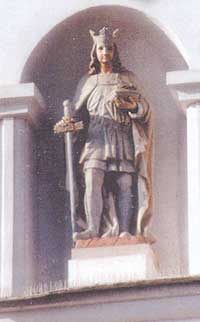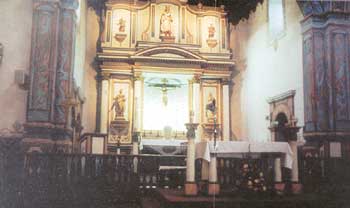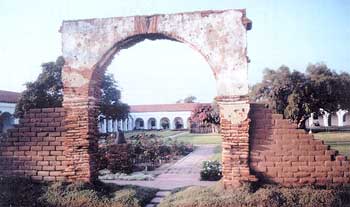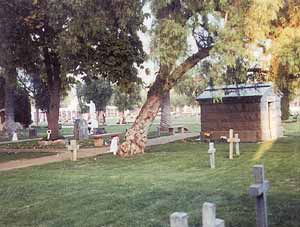MISSION SAN LUIS REY
This display is the second of its kind to appear in The Angelus (see "Mission San Juan Capistrano," The Angelus, April 2004). San Luis Rey de Francia was one of the 21 missions of what was called El Camino Real. It was named in honor of St. Louis IX, King of France.
Like its sister missions, San Luis Rey was one of those established by the Franciscan Friars Minor and Jesuit missionaries which, starting in 1683, became a string of priories on the west coast of the North American continent divided into what was known as Lower (or Old) California and Upper California. The former were located in today's Mexico, the latter in the present State of California. They doubled as presidios–or forts–by which Spain defended her claims of discovey against the threat from Russia, who showed desire for her possessions.
Mission San Luis Rey was founded July 16, 1798 by Fr. Fermin de Lasuen, successor to Fr. Junipero Serra. But from its foundation until his departure in 1832, Padre Antonio Peyri was the Franciscan in charge. Mission San Luis Rey became home to approximately 3,000 Indians which have since been called Luisenos after the patron of the mission. Of all the California missions, it had one of the most extensive chains of outposts, covering an area of around 1,000 square miles. These consisted of outlying ranches and asistencias (sub-missions) for farming and grazing. Many had storehouses and homes for the mission foremen. Some also had chapels. The outposts provided support for the mission and also allowed baptized Indians to remain in their native villages and serve the mission by working on the ranches.
 |
|
| Statue of St. Louis IX, sainted king of France, located above the entrance to the church. St. Louis was a Third Order member of the Franciscans, founders of the mission. |
|
The San Luis Rey mission church was constructed between 1811-15 by Padre Peyri. Like all of the missions, San Luis Rey was taken over by the Mexican government in 1834. The Franciscans managed to operate the church until 1847 when the last pastor died. From 1847-57 the U.S. Army occupied the mission grounds and actively assisted nearby ranchers to dismantle the church and other mission buildings for building material. The mission was returned to the Church in 1865, but remained abandoned until 1892 when a group of Franciscans from Zacatecas, Mexico (near Mexico City and the village of Guadalupe) moved in with plans to establish a Franciscan novitiate house. From 1892-1912, there was an effort to repair the church and rebuild the adjoining mission buildings. The inner quadrangle was reconstructed as a college in 1949 but now serves as a Novus Ordo retreat center (which is off-limits to visitors). The church exterior was last renovated and structurally reinforced in 1984.
The mission is located roughly five miles from the Pacific coastline and 15 miles from the foothills of the coastal mountains. It was situated about 35 miles north of Mission San Diego and 32 miles south of Mission San Juan Capistrano. The order to found Mission San Luis Rey caused some difficulties because the valley in which it was to be located was without any running water or spring with which to grow the crops necessary to attract the natives to the Catholic Faith. To provide water, the Franciscans dredged out a shallow marsh on a mesa near the mission, forcing the water up and retaining it by dams so that it could be used. An arroyo–a gulley–trickled with runoff water from the Sierra Madre during the rainy season from November to June. The modest and finicky stream was called the San Luis Rey River. It was directed via an aqueduct into small channels that emptied into pools where the Indians mainly gathered to do laundry and less often to bathe. This was called the lavanderias (washing area). Preservation of water was key because, outside the rainy season, the arroyo was lost in the sand and could not be counted on at seed time.
The network of outlying outposts of Mission San Luis Rey was planned around water resources. Fifteen miles to the northeast the Mission had a station called San Antonio de Pala with a church (still used today by visiting priests), dwellings, granaries, feedlots, and vineyards, fruit and olive orchards. Its buildings were begun in 1810. It was big enough on its own to be raised to full mission status as part of a second chain of inland missions, but the plan never came to fruition. Four miles to the north of San Luis Rey was a site called Santa Margarita where wheat, corn, beans, and barley were raised with runoff water from the inland mountains. An adobe house built here in 1806 for the site foreman has since been enlarged and is today the Base Commander's residence for the U.S. Army's Camp Pendleton. Seven miles farther north up the Pacific coast was Rancho San Pedro (also known as Rancho Las Flores or San Onofre), built in 1823, with granaries and a chapel. It adjoined Mission San Juan Capistrano's Rancho San Mateo to the north. Here on the mesa plains, wheat and barley were raised, irrigated by freshwater drawn from natural stone pools near the ocean. The Rancho San Pedro bell tower was used as a navigational landmark by early sailing ships. Since 1973, the area around the ruins of this asistencia has been leased to the Orange County Council of the Boy Scouts of America which operates a weekend camp here known as "Rancho Las Flores." This locale was called Las Pulgas and the canyon nearby still bears this name. Still farther north was Rancho San Jacinto (built in 1821), 30 miles away, with adobe houses for those tending the livestock pastured there. This stood just north of the intersection of today's Ramona Expressway and Warren Road. It was rebuilt several times before a fire in 1969 destroyed it.

Main altar. Since the church is now used by the Novus Ordo,
a table has been put in front of the altar rail,
but they could not otherwise alter the appearance of the interior
due to historical protection granted to the mission.
The ingenious stewardship of precious water resources and cropland by Mission San Luis Rey was responsible for its bountiful harvests and large livestock herds, winning for it the title "King of the Missions." In 1827, Padre Antonio Peyri prepared a report for the Mexican government stating, "The Mission Indians at present own 22,610 head of cattle, 27,412 sheep, 1,120 goats, 280 pigs, 1,501 horses of all kinds, and 235 mules."
Between the ranchos, sites, and stations, the valleys and mesas were covered with thick underbrush that was used for firewood. Five miles east of station San Antonio de Pala (about 22 from the Mission) was what is today called Palomar Mountain. Here there was a forest of pines and firs where needed timber for building was cut.
The buildings and retaining walls at Mission San Luis Rey were constructed out of locally-made adobe, a mud and straw brick, that is sun-dried, but not fired. Unfired brick is susceptible to weathering and if left unprotected falls apart readily especially when exposed to water. To prevent this, the missionaries coated the walls with a lime plaster, giving to them their characteristic white appearance. By 1830, the mission was the largest building in California.

A remnant of the original mission archway, stripped of most of its lime plastering,
looking into the reconstructed quadrangle now serving as a retreat center.
All efforts of the mission were to convert the natives to the True Faith and provide for them a society in which they could live and die in that Faith. In 1811, Padre Peyri penned a mission record of the California Indians from which we draw this excerpt:
Fights arise over any sort of trifle, and they readily kill one another. They throw seeds, beads, and other objects into the fire in which they burn their dead....
We have not observed any other idolatry among these Indians than that connected with certain birds called azuts, which really are a kind of very large vulture [i.e., condor or eagle–Ed.] ....The chief raises them with much attention and care until they are grown up; when, being of good size, the Indians make their great festival with the following ceremonies. The night before the festival they put the azuts in the middle of a large circle of themselves. While they dance and sing, and while old men and women are blowing out towards all points of the compass and making a thousand strange faces and grimaces, they very slowly kill the birds [by crushing them]. When they are dead they extinguish the fire and all break out in wails, shouts, and outcries, as if they were crazy, waving firebrands and striking blows as if they were furious, in such a way as to cause horror and confusion. After a considerable space of time,...they again light the fire. They skin the birds and throw their flesh on the fire. Meanwhile they begin to sing again with somewhat more sweetness. They keep the feathers of the birds with much veneration until the following day, when they make a sort of skirt of them. This skirt they put on the boy during the days that ceremony lasts [a kind of puberty ritual for young men–Ed.]. Wearing this skirt, he dances in the middle of a great circle of Indians,...We made the most careful efforts to ascertain the purpose of this ritual, but we never have been able to extract anything else than that their ancestors made it.
In order to win in their games of obligations [duels–Ed.] they drink a liquid they call maul, made from the root of toloache pounded and mixed with water. This drink renders them inebriated, and at times they give forth what they have in their stomach....These Indians do not use any sort of unusual drink, other than that made from toloache or maul [i.e., jimson-weed, by which young men received knowledge of the religious beliefs and practices of the tribe–Ed.]. This drink does them so much damage that if they drink a quantity and do not vomit they die in their intoxication foaming at the mouth.
When there is an eclipse of the sun or of the moon they shout with very loud outcries, making noises by clapping their hands and in other ways. On being asked the reason, they have always answered us that they believe an animal was trying to eat the sun or the moon, and that they did these extreme things to frighten him, thinking that if he ate them they would all perish.
The method observed by these Indians in their illnesses is as follows: For external matters, such as wounds, they make a tight bandage above the wound, with the end that the illness may not go up higher. [They use a variety of plasters, cooked and chewed.] There is another herb which occurs on the seashore. This they burn and put the ashes on the wound. We do not know the name of this plant, but they call it chaeca. If the wound is a burn, they follow the same treatment as regards the bandage, but in addition they put on powdered prickly pear leaf or more often powdered excrement of the jackrabbit or rabbit....If the trouble is the bite of a poisonous animal, they use, again in addition to the bandage, a stone similar to lapis. This stone they soak in the mouth, and when it has become wet they apply some of the moisture to the wound.

In the case of internal illnesses they tie up very tight the part of the body which hurts them, which we have observed to be most commonly the head....They do not make use of blood-letting. They have certain doctors who suck the sick person where ever he feels most pain, and presently they extract from the mouth blood, or sometimes pebbles, sticks, bones, or bits of skin which they have deceitfully provided themselves with before. Making the patient believe that this was the sickness, they presently blow towards the four winds and the sick man remains well satisfied, although sicker than before. They make him keep a diet so rigorously that ordinarily they do not give him anything unless he asks for it. They also practice the superstitions of dances, songs, and breathings for the sick, while a wizard makes a thousand faces over him. Thus, when the first remedies do not avail and one of the medicine men is employed, he does over him until he has killed the patient and made of him a martyr to the demon. In short, in the matter of their superstitions regarding sickness, idolatry, and witchcraft, they are so...full of deceit and reserved that, although I have been among them since the foundation of this mission, that which I can most readily manifest regarding these matters is my ignorance of them. They never confess more than they can deny.
They have an idea of a rational soul which they call chamson, and believe that when they die this goes below to tolmar where all come together and live forever in much happiness. With this they have, however, no idea of reward or punishment.
The mission cemetery dates back to the founding of the mission. It has been expanded over the years and is still being used. For many years it was the only cemetery in the North County (a term applied to those areas lying north of the city of San Diego) until the early 20th century when it became more populated. After reoccupying San Luis Rey in 1892, the Franciscans constructed a crypt along the side of the church facing the cemetery. This crypt is for the Franciscan monks who lived and died at the mission.
With Mexico's removal of the missions from control of the Catholic Church in the early 1830's, the Franciscan padres were forced to turn over control of the mission holdings to government-appointed administrators. Mission San Luis was secularized in 1834 and the government began to grant its outlying rancho to private rancheros, often the administrators themselves or their families. The asistencia of San Luis Rey named Mission San Diego, for instance, was located in the area called the Valle of San Juan since 1795. It is now commonly called the Warner Ranch, after J.J. Warner, who obtained it by Mexican land grant in 1844. After secularization, Mission San Luis Rey fell into disrepair but was restored beginning in 1892 with the Franciscans' return. From this time until 1912, the Franciscans were put under the guidance of Fr. Joseph Jeremias O'Keefe who during this period repaired the current church and rebuilt the living quarters on the foundations of the old mission (on which the museum sits today). Conservation of paintings and sculptures in the museum collections is an ongoing process and archeological investigations continue to unearth the past.
Photographs submitted by Troy Cox who assists at the Latin Mass, at the Latin Mass at Our Lady of the Angels, Arcadia, California. Story compiled from several sources by Fr. Kenneth Novak.
